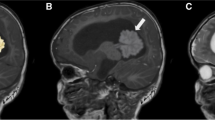Abstract
Background
Tumours of the posterior fossa associated with neurofibromatosis type 1 (NF1) are very infrequent. Series studying this association are seldom reported.
Personal experience
In a series of 600 NF1 patients studied during 39 years (1965-2004) only five (0.83%) had posterior fossa tumours. They were studied clinically, radiologically by computerized tomography (CT) or magnetic resonance (MR) and histologically. Four of them had astrocytomas but only in one case was the tumour primarily cerebellar while the tumour was primarily of the brain stem with invasion of the adjacent regions of one or both cerebellar hemispheres in three patients. The fifth tumour was a medulloblastoma that had a survival of 3 years following treatment. The patient with primary cerebellar astrocytoma is apparently cured 7 years after the removal of the tumour. The patients with the brain stem tumours extending to the cerebellum, showed a chronic slowly progressive cerebellar disease, but remain alive at age of more than 20 years (one was lost to follow-up).
Discussion and conclusion
The aim of this study was to present five children (one male and four females) less than 16 years of age when they were initially seen in our service, who had NF1 associates with posterior fossa tumours. This location is very uncommon in patients with NF1, in contrast with those located in other regions, such as pathway optic tumours and brain stem tumours. Most of these tumours are histologically benign (low grade astrocytomas). Only one patient in this series had a medulloblastoma, an exceptionally rare tumour seldom reported in patients with NF1.





Similar content being viewed by others
References
Pascual-Castroviejo I, Pascual-Pascual SI, Velazquez-Fragua R, Viaño J, García-Segura JM, Botella MP (2008) Neurofibromatosis tipo 1 y gliomas de vías ópticas. Una serie de 80 pacientes. Rev Neurol 46:530–536
Ruggieri M, Upadhyaya M, Di Rocco C, Gabriele A, Pascual-Castroviejo I (2008) Neurofibromatosis type 1 and related disorders. In: Ruggieri M, Pascual-Castroviejo I, Di Rocco C (eds) Neurocutaneous disorders. Phakomatoses and hamartoneoplastic syndromes. Springer, Wien, pp 51–151
Ilgren EB, Kinnier-Wilson LM, Stiller CA (1985) Gliomas in neurofibromatosis: a series of 89 cases with evidence for increased malignancy in associated cerebellar astrocytomas. Pathol Annu 79:582–588
Li J, Perry A, James D, Gutmann DH (2001) Cancer-related gene expression profiles in NF1-associated pilocytic astrocytomas. Neurology 56:885–890
Korf BR (2000) Malignancy in neurofibromatosis type 1. Oncologist 5:477–485
Pascual-Castroviejo I, Pascual-Pascual SI, Velazquez-Fragua R, Viaño J, García Segura JM (2007) Tumores del tronco cerebral asociados con neurofibromatosis tipo 1. Presentación de 20 pacientes infantiles. Neurología 22:846–852
Pascual-Castroviejo I (1992) Complications of neurofibromatosis type 1 in a series of 197 children. In: Fukuyama Y, Suzuki Y, Kamoshita S, Casaer P (eds) Fetal and perinatal neurology. Karger, Basel, pp 162–173
Pascual-Castroviejo I, Pascual-Pascual SI, Viaño J, Velazquez-Fragua R, Carceller F, Gutierrez-Molina M, Morales C (2010) Tumores de los hemisferios cerebrales en la neurofibromatosis tipo 1 (NF1) durante la infancia. Rev Neurol 50:453–457
National Institutes of Health Consensus Development Conference Statement (1988) Neurofibromatosis. Arch Neurol 45:575–578
Vinchon M, Soto-Ares G, Ruchoux M-M, Dhellemmas P (2000) Cerebellar gliomas in children with NF1: pathology and surgery. Childs Nerv Syst 16:417–420
Carella A, Medicamento N (1997) Malignant evolution of presumed benign lesions in the brain in neurofibromatosis: case report. Neuroradiology 39:639–641
Dunn IF, Agarwall PK, Papanastassiou AM, Butler WE, Smith ER (2007) Multiple pilocytic astrocytomas of the cerebellum in a 17-year-old patient with neurofibromatosis type 1. Childs Nerv Syst 23:1191–1194
Naidich MJ, Walker MT, Gottardi-Littell NR, Han G, Chandler JP (2004) Cerebellar pleomorphic xanthoastrocytoma in a patient with neurofibromatosis type 1. Neuroradiology 46:825–829
Kepes JJ, Rubinstein LJ, Eng LF (1979) Pleomorphic xanthoastrocytoma: a distinctive meningocerebral glioma of young subjects with relatively favourable prognosis. A study of 12 cases. Cancer 44:1839–1852
Corkill AGL, Ross CF (1969) A case of neurofibromatosis complicated by meduloblastoma, neurogenic sarcoma and radiation-induced carcinoma of thyroid. J Neurol Neurosurg Psychiatry 32:43–47
Meadows AT, D’Angio GJ, Mike V, Banfi A, Harris C, Jenkin RDT et al (1977) Pattern of second malignant neoplasms in children. Cancer 40:1903–1911
Pascual-Castroviejo I, Lobo Llorente A (2008) Posición anómala de la mano para la escritura en los niños con síndrome de déficit de atención e hiperactividad. Rev Neurol 47:129–133
Pascual-Castroviejo I (2001) Introducción e historia. Epidemiología y prevalencia. In: Pascual-Castroviejo I (ed) Neurofibromatosis. Escuela Libre Editorial Fundación Once. Madrid, pp. 13–23
Pascual-Castroviejo I (2008) Vascular birthmarks of infancy: PHACE association (Pascual-Castroviejo type II syndrome) and Cobb syndrome. In: Ruggieri M, Pascual-Castroviejo I, Di Rocco C (eds) Neurocutaneous disorders. Phakomatoses and Hamartoneoplastic Syndromes. Springer, Wien, pp 19–49
Ruggieri M, Packer RJ (2001) Why do benign astrocytomas become malignant in NF1? Neurology 56:827–829
Author information
Authors and Affiliations
Corresponding author
Rights and permissions
About this article
Cite this article
Pascual-Castroviejo, I., Pascual-Pascual, S.I., Viaño, J. et al. Posterior fossa tumors in children with neurofibromatosis type 1 (NF1). Childs Nerv Syst 26, 1599–1603 (2010). https://doi.org/10.1007/s00381-010-1163-5
Received:
Accepted:
Published:
Issue Date:
DOI: https://doi.org/10.1007/s00381-010-1163-5




